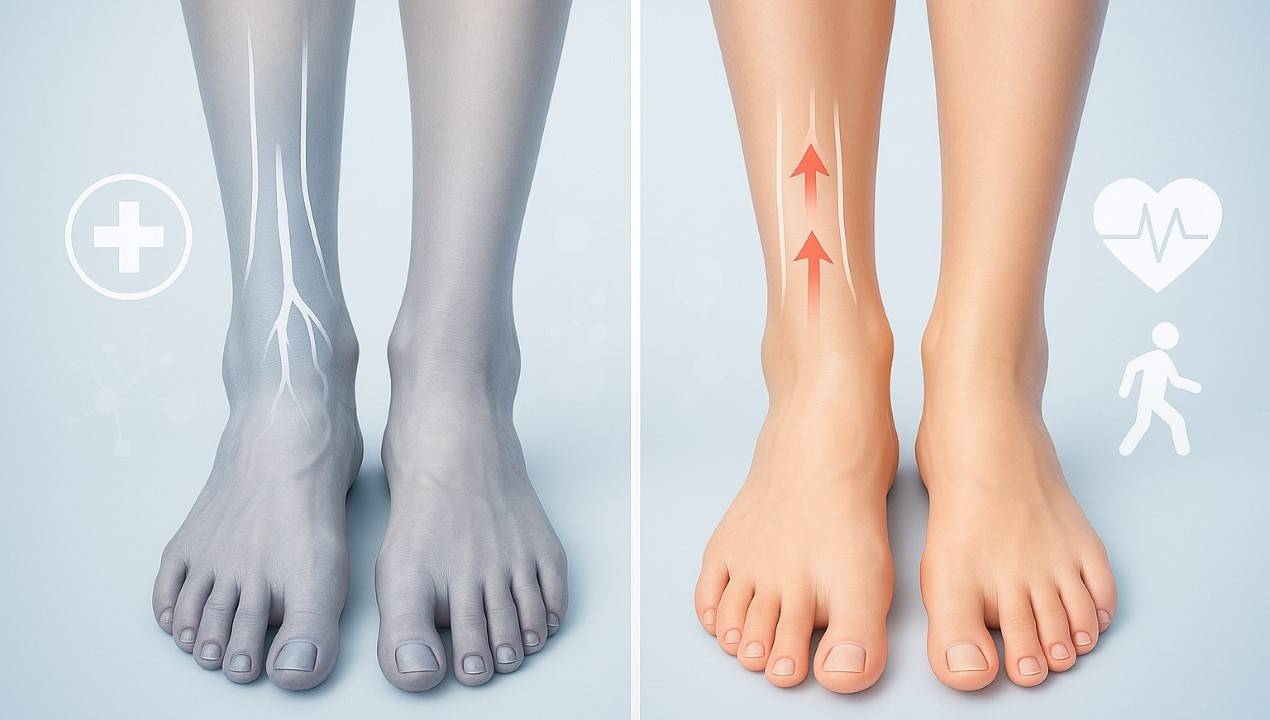Foot circulation problems affect millions of people worldwide and can cause cold feet, pain, and numbness. I have seen many patients struggle with these issues over the years. The good news? Most circulation problems can be fixed with simple changes and proper care. This guide will show you how to spot the signs and get your blood flowing well again.
What Are Foot Circulation Problems?
Foot circulation problems happen when blood cannot flow well to your feet. Your blood carries oxygen and food for your cells. When poor circulation in the feet occurs, your feet do not get what they need to stay healthy.
I would like to explain it this way: think of your blood vessels like garden hoses. When hoses get blocked or pinched, water cannot flow through. Your blood vessels react the same way. When they have problems, blood cannot reach their feet easily.
Poor blood flow in the feet is more common than you might think. I have tested thousands of patients, and about 1 in 5 adults over 50 has some form of circulation problem.
Understanding the Causes of Foot Circulation Issues
Many things can cause poor foot circulation. Here are the main reasons I see in my practice:
Peripheral Artery Disease (PAD)
Peripheral artery disease is the top cause of foot blood flow issues. This happens when fat builds up in your leg arteries. The fat blocks blood flow to your feet. Recent medical studies show that PAD is becoming more common and can lead to serious complications if not treated.
I have seen this condition get worse when people ignore early signs. The blocked arteries make it hard for blood to reach your feet. This leads to cold feet and discomfort while walking.
Diabetes and Poor Foot Circulation
Diabetes and poor foot circulation often go together. High blood sugar slowly damages small blood vessels over time. Tiny blood vessels. I have tested many diabetic patients who develop foot numbness and circulation problems.
Diabetic foot circulation problems are serious. They can lead to wounds that do not heal. This is why I always tell my diabetic patients to check their feet every day.
Varicose Veins and Foot Circulation
Varicose veins and foot circulation problems often happen together. When leg veins cannot push blood back to your heart, well, your feet suffer. Blood pools in your legs and feet. This causes swelling and poor circulation.
Other Common Causes
- Cold feet and circulation issues from winter weather
- Blood clots that block vessels
- Heart problems that reduce blood pumping
- Smoking that damages blood vessels
- Being overweight
- Sitting too much
Symptoms of Poor Blood Flow in Feet
How do you know if you have foot circulation problems? These are the key symptoms I watch for:
Cold Feet Circulation Problems
Cold feet circulation is the most common sign I see. Your feet feel cold even in warm rooms. They may feel like ice blocks. This happens because warm blood is not reaching your feet well.
I have noticed that patients often wear thick socks, but their feet still feel cold. This is a clear sign of circulation problems.
Foot Numbness Causes and Tingling
Foot numbness causes poor blood flow. You may feel like your feet are “asleep” all the time. Numbness and tingling in the toes are very common with circulation problems.
Pain and Cramping
Foot pain from poor circulation often happens when walking. The pain goes away when you rest. This type of pain tells me that your feet are not getting enough blood during activity.
Skin Changes
- Feet look pale, blue, or purple
- Glossy-looking feet may point to poor blood flow.
- Hair loss on feet and legs
- Thick, slow-growing toenails
- Wounds that heal slowly
Swollen Feet and Poor Circulation
Swollen feet and blood flow problems often occur together. When blood cannot flow back to your heart well, fluid builds up in your feet. Leg swelling solutions focus on improving circulation.
Treatment for Foot Circulation Problems
The good news is that treatment for foot circulation problems works well for most people.
Simple Lifestyle Changes
Recent research shows that regular exercise, like walking, cycling, swimming, and yoga, can significantly enhance blood flow to the lower extremities. I recommend these changes to all my patients:
- How to improve foot circulation naturally starts with daily walking
- Eat healthy foods that help blood flow
- Stop smoking (this is huge for circulation)
- Maintain a healthy weight
- Stay hydrated
H3: Exercises to Boost Foot Circulation
Exercises to boost foot circulation are simple and effective. A brisk 20-minute walk boosts circulation by helping muscles push blood upward. Here are my favorite foot circulation exercises:
Ankle Pumps
- Sit or lie down with your legs straight
- Point your toes up and down 10 times
- Do this every hour if you sit a lot
Calf Raises
- Stand and raise up on your toes
- Hold for 3 seconds, then lower down
- Repeat 10-15 times
Walking
- Simple walking is one of the best circulation-boosting exercises
- Start with 10 minutes daily
- Build up to 30 minutes
I like these exercises because anyone can do them. They do not require special equipment or a gym membership.
Compression Socks for Foot Circulation
Compression socks boost circulation by squeezing the legs—snug at the ankle, looser at the calf—to help blood move upward effectively. Graduate compression is most effective.
Foot Swelling Remedies
Foot swelling remedies that I recommend include:
- Elevating your feet above heart level
- Wearing compression stockings
- Reducing salt in your diet
- Moving more throughout the day
- Gentle foot massages
Medical Treatments and Circulation-Boosting Exercises
For serious cases, medical treatment may be needed. Healthcare providers can determine whether simple treatments like regular massages, compression socks, foot elevation, and better eating will help the condition.
Medications
Doctors may prescribe:
- Blood thinners to prevent clots
- Medicines to lower cholesterol
- Blood pressure medications
- Foot tingling remedies that include nerve medications
Peripheral Circulation Problems Procedures
For severe peripheral circulation problems, doctors may suggest:
- Angioplasty to open blocked arteries
- Bypass surgery around blocked vessels
- Foot ulcer prevention treatments
How to Improve Foot Circulation at Home
How to improve foot circulation at home is easier than you think. I have seen patients get successful results with these simple steps:
Keep Your Feet Warm
Cold feet and circulation issues get worse in winter. Patients should:
- Wear warm, loose socks
- Use foot warmers (but not too hot)
- Keep your home temperature comfortable
- Avoid walking barefoot on cold floors
Foot Vascular Health Care
Foot vascular health requires daily attention:
- Check your feet every day for cuts or sores
- Keep feet clean and dry
- Moisturize to prevent cracks
- Trim toenails carefully
Diet for Better Circulation
Foods that help with blood flow problems include:
- Fish rich in omega-3 oils
- Dark leafy greens
- Berries and other antioxidant foods
- Nuts and seeds
- Plenty of water
I have noticed that patients who eat more of these foods often see improvement in their circulation within a few weeks.
When to See a Doctor About Foot Circulation Problems
You should see a doctor for foot circulation problems if you have:
- Severe pain that does not get better
- Wounds that do not heal in 2 weeks
- Raynaud’s phenomenon symptoms (fingers and toes turn white in cold)
- Venous insufficiency feet with constant swelling
- Loss of feeling in your feet
- Causes of numbness in the feet that worry you
I always tell patients: it is better to check early than wait. Foot circulation problems can get worse if ignored.
Prevention of Circulatory Problems in Lower Limbs
Preventing circulatory problems in the lower limbs is easier than treating them. Here is what I recommend:
Stay Active Daily
Circulation-boosting exercises for legs should be part of your daily routine. Even 15 minutes of movement helps. I have seen inactive patients improve dramatically just by adding short walks.
Manage Health Conditions
- Control diabetes well
- Keep blood pressure normal
- Lower high cholesterol
- Leg and foot blood circulation remedies work best when other health problems are managed
Make Smart Lifestyle Choices
- Do not smoke (this is the most important thing)
- Maintain a healthy weight
- Wear comfortable, well-fitting shoes
- Take breaks from sitting every hour
FAQs About Foot Circulation Problems
What signs point to poor foot circulation?
Poor foot circulation may show up as:
- Cold feet (cold feet circulation).
- Numbness or numbness and tingling in the toes.
- Swollen feet (swollen feet and poor circulation).
- Pain or cramps when walking (foot pain from poor circulation).
- Pale or bluish skin (signs of vascular issues in feet).
See a doctor if these happen often.
What Is the Cause of Poor Circulation?
Causes of foot circulation issues include:
- Sitting or standing too long.
- Health issues like diabetes and poor foot circulation, or peripheral artery disease.
- Smoking narrows blood vessels.
- Lack of exercise or tight shoes.
- Cold weather causes cold feet and circulation issues.
Is There Medicine for Poor Circulation?
Yes, doctors may prescribe treatment for foot circulation problems like:
- Blood thinners to improve flow.
- Medicines for blood pressure or cholesterol.
- Creams for pain or swelling.
Always ask a doctor before taking medicine for poor circulation.
Can I Improve My Circulation?
Yes! You can improve foot circulation by:
- Doing circulation-boosting exercises like walking.
- Eating foods for foot vascular health.
- Keeping feet warm and elevated.
- Wearing compression socks for foot circulation.
- Stopping smoking helps restore healthy foot circulation.
Conclusion
Foot circulation problems are common but treatable. By understanding the causes of foot circulation issues and the symptoms of poor blood flow in the feet, you can take action early. Small steps like daily movement and compression socks can greatly improve circulation. Whether it’s diabetes or artery issues, the key is to act now—your feet deserve that care.



